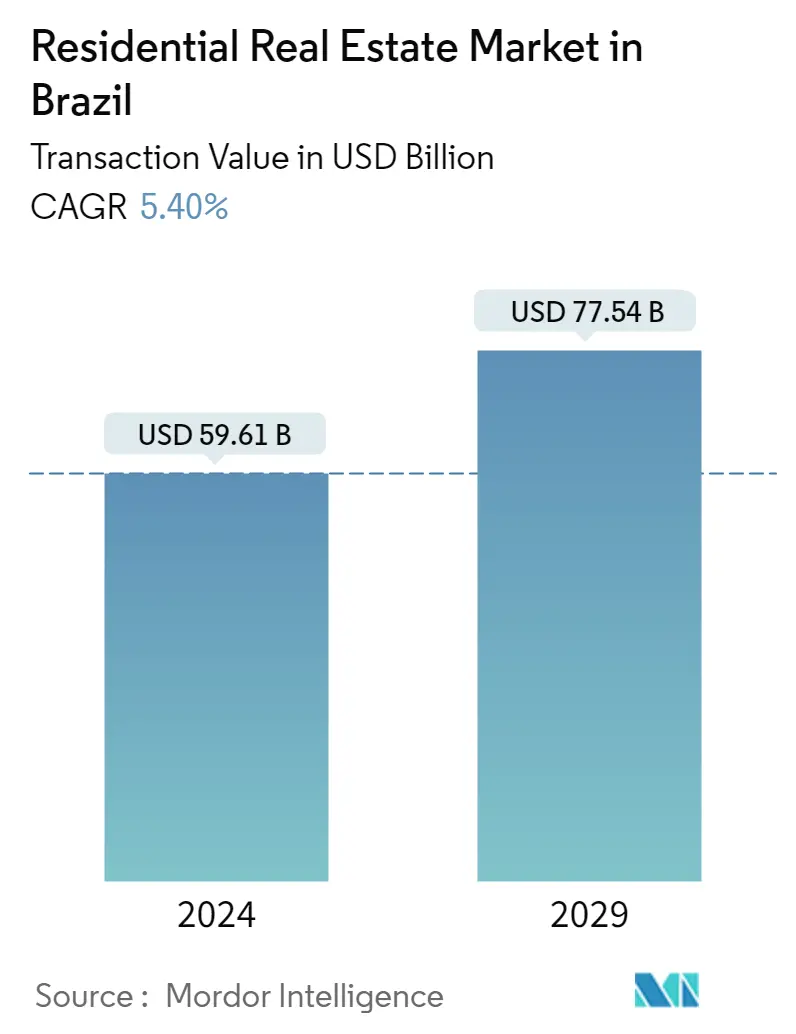Market Size of Residential Real Estate Industry in Brazil

| Study Period | 2019 - 2029 |
| Base Year For Estimation | 2023 |
| Market Size (2024) | USD 59.61 Billion |
| Market Size (2029) | USD 77.54 Billion |
| CAGR (2024 - 2029) | 5.40 % |
| Market Concentration | Low |
Major Players.webp)
*Disclaimer: Major Players sorted in no particular order |
Brazilian Residential Real Estate Market Analysis
The Residential Real Estate Market in Brazil Market size in terms of transaction value is expected to grow from USD 59.61 billion in 2024 to USD 77.54 billion by 2029, at a CAGR of 5.40% during the forecast period (2024-2029).
- The COVID-19 pandemic slowed the recovery of Brazil's property market, with real house prices in Sao Paulo decreasing 5.51% until Q3 2021, following a 0.21% increase the previous year. After the recessionary period in 2020 caused by the COVID-19 outbreak, the real estate market in Brazil significantly improved, overcoming the economic downturn, notably in the residential sector.
- In the first four months of 2021, about 13,012 homes were sold, compared to 8,738 in the same period in 2020, according to Rio de Janeiro's Housing Union. The Brazilian Association of Financial and Capital Market Entities says that real estate funds in the Latin American country made $5,4 million in the first half of 2021. The figure represents a growth of 44.3% over the funds raised in the same period in 2020
- In October 2021, the Sao Paulo State Housing Union said that 5,555 new homes were sold in the city of Sao Paulo. This was almost the same number as the previous year. Brazilian President Jair Bolsonaro got a lot of criticism for how he handled the COVID-19 pandemic. He refused to back steps that would have stopped the virus from spreading. The central bank of Brazil announced that the interest rate would go up by 75 basis points, to 4.25 percent, for the third time in 2021. They also said that they expected a similar rise in August 2021. The country's economy expanded 1% year-on-year in the first quarter of 2021, beating market estimates of 0.8% growth.
Brazilian Residential Real Estate Industry Segmentation
Residential real estate is broadly defined as real property (land and any buildings on it) used for residential purposes, the most common example being single-family homes. Residential real estate is an area developed for people to live in. As defined by local zoning ordinances, residential real estate cannot be used for commercial or industrial purposes.
The Residential Real Estate Market in Brazil is Segmented by Type (Villas and Landed Houses, Apartments and Condominiums). The report offers market size and forecasts in value ( USD billion) for all the above segments.
| Market Segmentation | ||||
|
Residential Real Estate Market in Brazil Size Summary
The Brazilian residential real estate market is poised for significant growth over the forecast period, driven by a recovery from the economic impacts of the COVID-19 pandemic. The market has shown resilience, with a notable rebound in the residential sector following a recessionary phase. The demand for residential properties, particularly in major cities like S√£o Paulo and Rio de Janeiro, has been bolstered by a shift in consumer preferences towards larger and more comfortable living spaces. This trend has been particularly pronounced in the luxury segment, where affluent buyers are seeking high-end properties that offer quality and space. The market's recovery has been supported by favorable financing conditions, including low mortgage rates, which have encouraged both demand and investment in residential real estate.
The competitive landscape of Brazil's residential real estate market is characterized by increased activity from both new and established developers, contributing to a dynamic and attractive investment environment. Major players such as MRV Engenharia, Cyrela Brazil Realty, and Direcional Engenharia are actively participating in the market, with new projects and partnerships enhancing their portfolios. The market has also seen a rise in real estate funds, reflecting growing investor confidence. As demand continues to rise, particularly in the luxury and mid-sized residential segments, the market is expected to expand further, offering opportunities for growth and development in the coming years.
Residential Real Estate Market in Brazil Market Size - Table of Contents
-
1. Market Insights
-
1.1 Current Economic Scenario and Consumer Sentiment
-
1.2 Residential Real Estate Buying Trends - Socioeconomic and Demographic Insights
-
1.3 Government Initiatives and Regulatory Aspects for Residential Real Estate Sector
-
1.4 Insights into Size of Real Estate Lending and Loan to Value Trends
-
1.5 Insights into Interest Rate Regime for General Economy and Real Estate Lending
-
1.6 Insights into Rental Yields in Residential Real Estate Segment
-
1.7 Insights into Capital Market Penetration and REIT Presence in Residential Real Estate
-
1.8 Insights into Affordable Housing Support Provided by Government and Public-private Partnerships
-
1.9 Insights into Real Estate Tech and Startups Active in the Real Estate Segment (Broking, Social Media, Facility Management, and Property Management)
-
1.10 Impact of COVID-19 Pandemic on the Market
-
-
2. Market Segmentation
-
2.1 Market Segmentation
-
2.1.1 By Type
-
2.1.1.1 Villas and Landed Houses
-
2.1.1.2 Apartments and Condominiums
-
-
-
Residential Real Estate Market in Brazil Market Size FAQs
How big is the Brazil Residential Real Estate Market?
The Brazil Residential Real Estate Market size is expected to reach USD 59.61 billion in 2024 and grow at a CAGR of 5.40% to reach USD 77.54 billion by 2029.
What is the current Brazil Residential Real Estate Market size?
In 2024, the Brazil Residential Real Estate Market size is expected to reach USD 59.61 billion.

